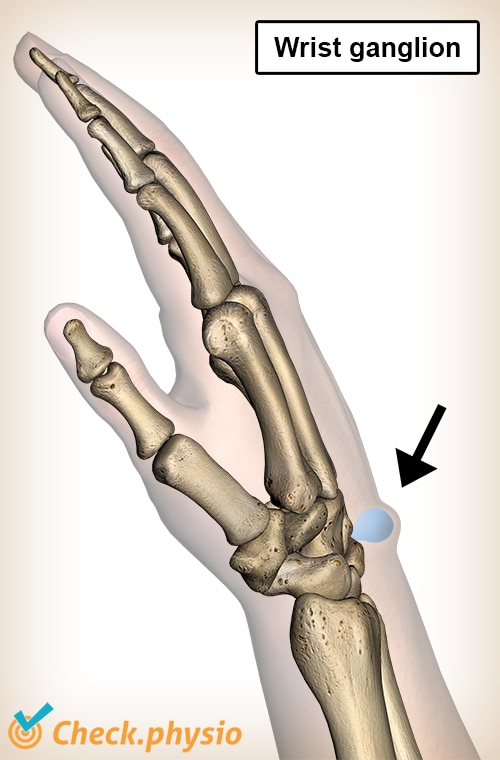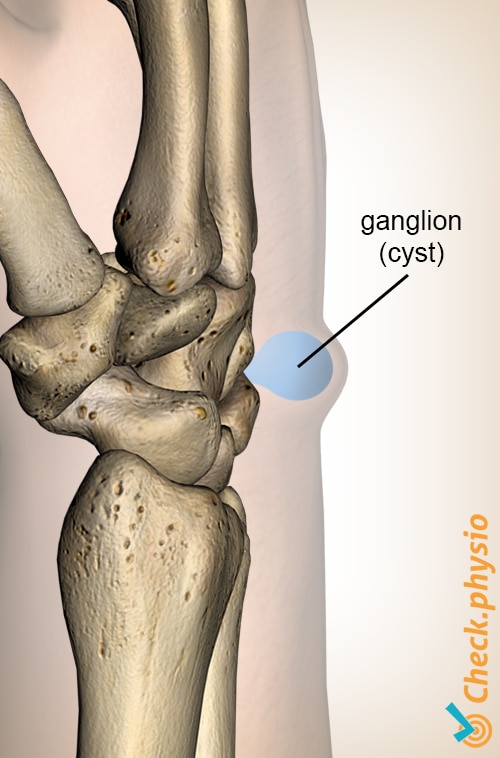Ganglion of the wrist
Mucous cyst of the wrist / mucoid cyst
A ganglion is a benign localized swelling in the hand or wrist. It is a cavity filled with jelly-like fluid. A ganglion is also called a cyst.

In general, a ganglion causes few or no functional problems. In more unusual cases, a ganglion may cause pain or restrict the mobility of a joint.
Description of condition
A ganglion is a condition that often occurs in the hand or wrist It is a local swelling that can vary in size and sometimes disappear spontaneously. Fluid runs into the ganglion through a connection, also called a stalk, from nearby joints or tendon sheaths. This fluid has a viscous structure.
Usually, a ganglion is seen at the top of the wrist. In rarer cases, it may be found at the underside of the wrist or in the fingers. When the ganglion is situated around the distal joint of one of the fingers, it is called a mucoid cyst.
Ganglions are more common in women than in men. About 70% of people with a ganglion are women.
Cause and history
An exact cause for a ganglion occurring is not yet known. It is often assumed that local irritation plays an important factor in its occurrence. Such an irritant may be a strain or local disorder of a joint or tendon sheath. For example, osteoarthritis, loose ligaments or inflammation.
In about 10% of cases, there has been a preceding trauma (accident or fall), but in most cases there is no clear cause.
Signs & symptoms
In most cases, a ganglion will not cause any symptoms, apart from a possible cosmetic problem. However, if it is located in an inconvenient place, or originates from an underlying wrist or hand problem, it can cause problems, such as:
- Local swelling that varies in size.
- Local pain (when pressure is applied).
- Pain during movement.
- Restriction of movement in the wrist or finger.
Diagnosis
A doctor or physiotherapist will ask a number of questions about the symptoms. This will allow them to get an idea of what might be going on. Then, during a physical examination, the movements of the hand and wrist will be examined and the physician will also be alert to any local swelling. This is generally a small, firm lump that becomes more visible with certain movements.
If in doubt, an ultrasound, X-ray or MRI may be carried out to confirm the diagnosis and rule out any other (underlying) conditions.
Treatment
If a ganglion does not cause any symptoms, it will not be treated. It is then sufficient to reassure the patient. When symptoms do occur, the ganglion can initially be emptied. This is done with a needle that is inserted into the swelling. After this, an anti-inflammatory drug may also be injected. The disadvantage of this is the fact that the ganglion often fills up again (quickly) and the symptoms return.
When a ganglion keeps reappearing or keeps causing symptoms, an operation may be a solution. The ganglion is then removed in its entirety. During the operation, the "stalk" is also removed so that the ganglion can no longer fill with fluid. If there is an underlying disorder, this should also be treated. Unfortunately, there is still a chance that the ganglion will return.
After the operation, the hand can be used normally again after 1 to 2 weeks.
Exercises
You can check your symptoms using the online physiotherapy check or make an appointment with a physiotherapy practice in your locality.

References
Nugteren, K. van & Winkel, D. (2006). Onderzoek en behandeling van de hand, het polsgewricht. Houten: Bohn Stafleu van Loghum.



